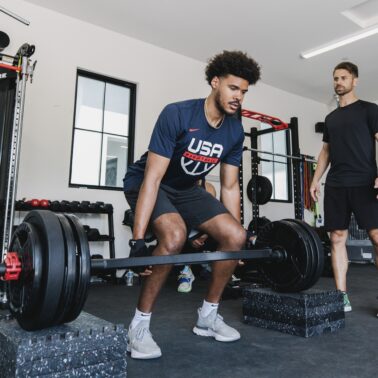“Force plates provide us with the necessary information to dial in the specificity of training in order to achieve optimal results.”
Adam Loiacono
In the dynamic world of professional sports, where every inch gained and every second shaved off counts, the pursuit of peak performance is unceasing. It’s not just about training harder, but smarter. This is where innovative tools like force plates step into the spotlight, transforming the landscape of athlete profiling. In this article, we’ll delve into the powerful insights offered by force plates. We will also explore how they revolutionize training interventions for optimal performance.
The Foundation: Understanding Force Plates
Force plates, often referred to as “performance plates,” are sophisticated devices designed to measure the interaction between an athlete and the ground during various movements. These plates provide invaluable data, allowing sports scientists, coaches, and therapists to gain a deeper understanding of an athlete’s physical capabilities. By analyzing force plate data, professionals can fine-tune training programs, enhance rehab, and unlock the athlete’s true potential.
Force Plates: Metrics and Insights
There are hundreds of metrics that can be derived from force plates. Some of them are more useful than others and some are directly related to others. Over years of usage and analysis there tends to be (5) key metrics that offer insight that can directly influence your decision making around training and rehab.
- Concentric Rate of Force Development (cRFD): This metric measures how quickly an athlete can generate force during a concentric contraction, such as jumping or sprinting. A higher cRFD signifies explosive power, a critical asset in sports like basketball, soccer, and track and field.
- Eccentric Rate of Force Development (eRFD): The eRFD gauges an athlete’s ability to absorb force during eccentric movements, like landing from a jump. A well-balanced eRFD helps prevent injuries by demonstrating an athlete’s control over deceleration forces.
- Modified Reactive Strength Index (mRSI): The mRSI combines jump height with ground contact time, reflecting an athlete’s ability to quickly transition from eccentric to concentric movements. A high mRSI points to superior elasticity and reactive power, essential in sports demanding rapid changes of direction.
- Jump Height: This straightforward metric reveals an athlete’s explosive power and lower-body strength. It’s particularly useful for sports requiring vertical leaps, such as basketball and volleyball.
- Asymmetry Analysis: Force plates offer insights into an athlete’s movement symmetry, flagging potential imbalances that might lead to injuries. Addressing these discrepancies can enhance performance and mitigate injury risks.
Training Interventions: Turning Data into Action
Interpreting force plate data is just the beginning. The true value lies in the actionable insights that guide training interventions. Let’s explore how these metrics translate into targeted strategies:
- cRFD Enhancement: Athletes with lower cRFD can benefit from explosive strength training, incorporating exercises like plyometrics and Olympic lifts. Focus on maximizing the force generated in short time frames to boost explosive power.
- eRFD Optimization: Building eccentric strength is crucial to avoid injuries during deceleration movements. Incorporate exercises emphasizing controlled landings and eccentric-focused strength training.
- mRSI Improvement: To enhance mRSI, combine plyometric exercises with reactive drills. Depth jumps, bounding, and agility ladder drills can help athletes develop rapid transitions between eccentric and concentric phases.
- Vertical Leap Enhancement: If jump height is a priority, integrate targeted exercises like squat jumps, box jumps, and depth jumps. Progressive overload and proper technique are key factors here.
- Asymmetry Correction: Work with a qualified physical therapist to address movement imbalances identified through force plate analysis. Tailored exercises and corrective strategies can restore symmetry and reduce injury risks.
Force Plates & the Journey Towards Peak Performance
In the realm of professional sports, the journey towards peak performance is as much science as it is art. Utilizing force plates in athlete profiling elevates this journey by offering quantitative insights that guide training decisions. Through metrics like cRFD, eRFD, coaches and therapists can refine training interventions and optimize movement.
Remember, effective athlete profiling isn’t just about the numbers; it’s about understanding the individual behind the data. By harnessing the potential of force plates, professionals can tailor training programs that respect an athlete’s strengths, mitigate weaknesses, and unlock their ultimate performance capabilities.
In conclusion, force plates have transcended the realm of scientific research to become indispensable tools in the arsenal of sports professionals. They empower us to bridge the gap between potential and achievement, turning small wins into monumental victories on the field, court, or track. So, as the world of sports continues to evolve, embrace the insights offered by force plates and embark on a journey to optimize performance like never before



